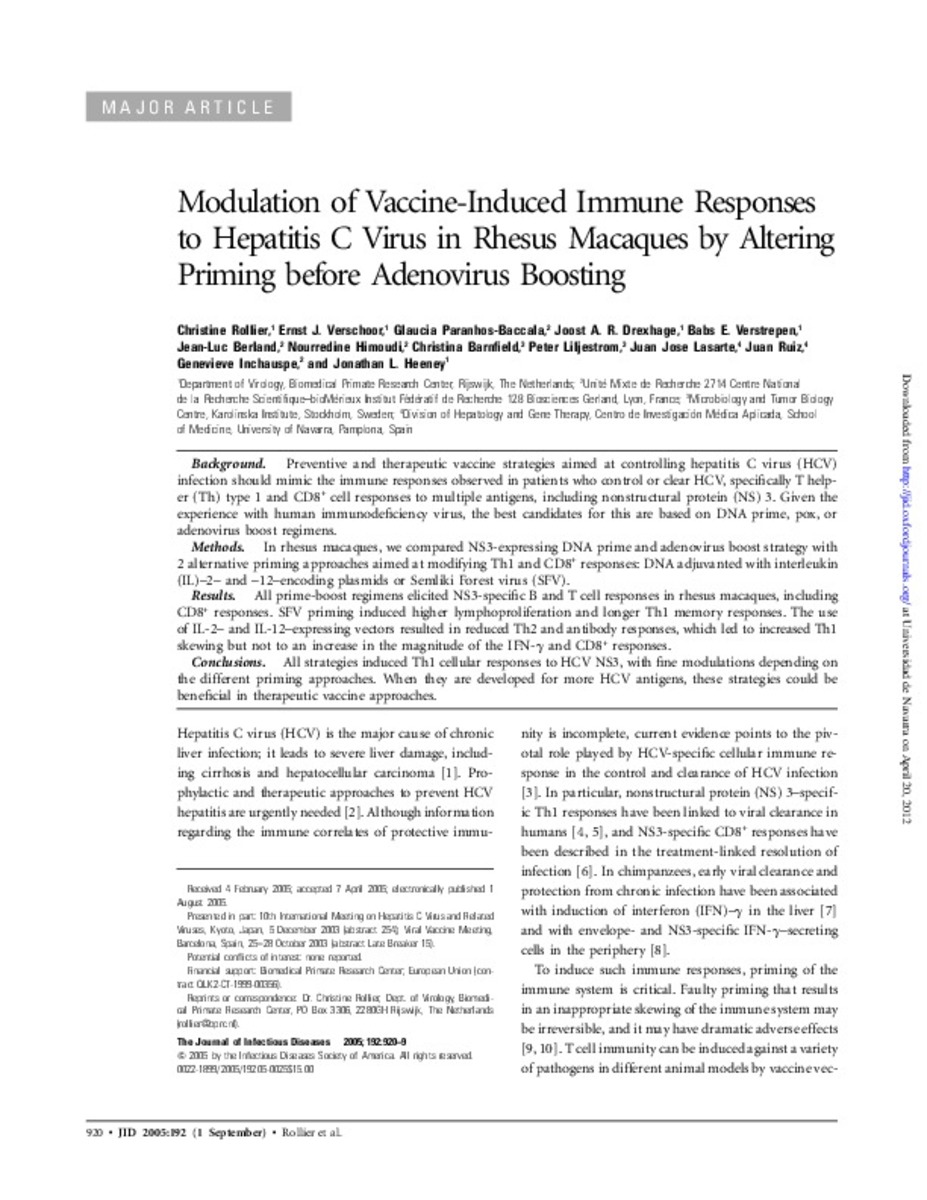Full metadata record
| DC Field | Value | Language |
|---|---|---|
| dc.creator | Rollier, C.S. (Christine S.) | - |
| dc.creator | Verschoor, E.J. (Ernst J.) | - |
| dc.creator | Paranhos-Baccala, G. (Glaucia) | - |
| dc.creator | Drexhage, J.A.R. (Joost A.R.) | - |
| dc.creator | Verstrepen, B.E. (Babs E.) | - |
| dc.creator | Berland, J.L. (Jean-Luc) | - |
| dc.creator | Himoudi, N. (Nourredine) | - |
| dc.creator | Barnfield, C. (Christina) | - |
| dc.creator | Liljestrom, P. (Peter) | - |
| dc.creator | Lasarte, J.J. (Juan José) | - |
| dc.creator | Ruiz, J. (Juan) | - |
| dc.creator | Inchauspe, G. (Geneviese) | - |
| dc.creator | Heeney, J.L. (Jonathan L.) | - |
| dc.date.accessioned | 2012-04-23T07:43:42Z | - |
| dc.date.available | 2012-04-23T07:43:42Z | - |
| dc.date.issued | 2005 | - |
| dc.identifier.citation | Rollier C, Verschoor EJ, Paranhos-Baccala G, Drexhage JA, Verstrepen BE, Berland JL, et al. Modulation of vaccine-induced immune responses to hepatitis C virus in rhesus macaques by altering priming before adenovirus boosting. J Infect Dis 2005 Sep 1;192(5):920-929. | es_ES |
| dc.identifier.issn | 1537-6613 | - |
| dc.identifier.uri | https://hdl.handle.net/10171/21726 | - |
| dc.description.abstract | BACKGROUND: Preventive and therapeutic vaccine strategies aimed at controlling hepatitis C virus (HCV) infection should mimic the immune responses observed in patients who control or clear HCV, specifically T helper (Th) type 1 and CD8+ cell responses to multiple antigens, including nonstructural protein (NS) 3. Given the experience with human immunodeficiency virus, the best candidates for this are based on DNA prime, pox, or adenovirus boost regimens. METHODS: In rhesus macaques, we compared NS3-expressing DNA prime and adenovirus boost strategy with 2 alternative priming approaches aimed at modifying Th1 and CD8+ responses: DNA adjuvanted with interleukin (IL)-2- and -12-encoding plasmids or Semliki Forest virus (SFV). RESULTS: All prime-boost regimens elicited NS3-specific B and T cell responses in rhesus macaques, including CD8+ responses. SFV priming induced higher lymphoproliferation and longer Th1 memory responses. The use of IL-2- and IL-12-expressing vectors resulted in reduced Th2 and antibody responses, which led to increased Th1 skewing but not to an increase in the magnitude of the IFN- gamma and CD8+ responses. CONCLUSIONS: All strategies induced Th1 cellular responses to HCV NS3, with fine modulations depending on the different priming approaches. When they are developed for more HCV antigens, these strategies could be beneficial in therapeutic vaccine approaches. | es_ES |
| dc.language.iso | eng | es_ES |
| dc.publisher | Oxford University Press | es_ES |
| dc.rights | info:eu-repo/semantics/openAccess | es_ES |
| dc.subject | Hepacivirus/immunology | es_ES |
| dc.subject | Hepatitis C/immunology | es_ES |
| dc.subject | Immunization/methods | es_ES |
| dc.subject | Viral Hepatitis Vaccines/immunology | es_ES |
| dc.subject | Viral Nonstructural Proteins/immunology | es_ES |
| dc.title | Modulation of vaccine-induced immune responses to hepatitis C virus in rhesus macaques by altering priming before adenovirus boosting | es_ES |
| dc.type | info:eu-repo/semantics/article | es_ES |
| dc.relation.publisherversion | http://jid.oxfordjournals.org/content/192/5/920 | es_ES |
| dc.type.driver | info:eu-repo/semantics/article | es_ES |
Files in This Item:
Statistics and impact
Items in Dadun are protected by copyright, with all rights reserved, unless otherwise indicated.






